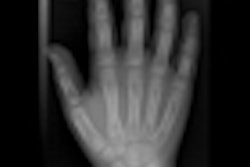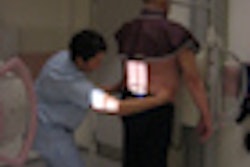VIENNA - New insurance laws, a keener recognition of patients' values, and an expanding list of professional duties amplify the pressure on radiographers to implement evidence-based practice. Early research findings from three Northern European pilot studies were discussed at the European Congress of Radiology (ECR).
"Implementing evidence-based practice [EBP] into your radiography department is not an overwhelming or impossible task -- and, once you do it, you will find that it enhances your job satisfaction as well as the quality of your practice," said Nina Kleven-Madsen of Haukeland University Hospital in Bergen, Norway.
In an attempt to show that the advantages of evidence-based practice can translate into superior service and experience for patients, a research group comprising students and management evaluated the benefits of introducing EBP to a pediatric diagnostic radiography department.
Radiographers are skilled in their practice and tend to seek the most efficient and effective methods. Yet, the challenge to base EBP routinely at the heart of decisions is exacerbated by their lack of time, knowledge, and specific evidence-interrogation competencies.
Many overworked radiographers will choose to consult with senior colleagues in preference (and in place of) scanning the published evidence and research. Other barriers include a lack of support from peers and a "human resistance to change."
With a team comprising both experienced and student (2nd and 3rd year) radiographers, plus a university librarian, Kleven-Madsen assessed their cooperation in performing effective literature searches and procedure evaluation, and judged their collective ability to distill and implement the best practice available.
Participants were tasked specifically with finding the best answer to the question, "Is there a dose reduction to mammary glands when anteroposterior is switched to posteroanterior in scoliosis imaging of adolescent girls?"
The exercise revealed that while contemporary practice is to a degree aligned with evidence-based practice, more systematic work would help to establish consensus on best practice -- thereby raising the advantages of EBP in imaging in general.
The Norwegian researchers also concluded that collaboration in implementing evidence-based practice might improve the learning environment for students, making them more accountable during their practical placements.
The project was a joint program between Haukeland University Hospital and Bergen University College, also in Norway. In summing up, Kleven-Madsen encouraged the full room of ECR delegates to see beyond the barriers in bringing EBP into routine practice.
"An evidence-based approach to your work is not difficult -- team up with colleagues who are interested and just get started," she said.
New thinking from Switzerland
In another presentation, early findings were offered from a collaboration between three tertiary health schools and one teaching referral hospital in the French-speaking area of Switzerland that partnered up to develop a new initiative in evidence-based practice, titled BEST (Bureau d'echanges des savoirs pour des pratiques exemplaires de soins).
The two-year pilot study, led by the University of Applied Sciences of Western Switzerland in Lausanne, is currently ongoing and was set up to evaluate BEST as a new tool to assist local radiographers in embracing EBP.
In the study, radiographers gather evidence to produce the "best practice" answer to a wealth of clinical questions, with the ultimate aim of improving the quality of care for patients through EBP.
For French-speaking researchers in this part of Europe, the common use of English in publishing and presenting "evidence" is an additional barrier to EBP implementation, as was noted in BEST.
Lead researcher Nicole Richli Meystre's Swiss team commenced a six-step process bringing together clinical expertise, patient preferences, and locally relevant standards under a single EBP umbrella:
- Formulate the right clinical question.
- Perform a targeted literature search.
- Provide a critical appraisal of the evidence.
- Feed local experience and expertise into the process, and assess how to implement.
- Implement best practice.
- Reflect and embed EBP into daily practice.
Initial results available to date suggest that with the right approach, the benefits of EBP can be translated into clinical advantages in radiography, and that projects such as BEST are useful in spotlighting means for improvement and encouraging progress within busy radiography departments.
Supporting evidence in ethical dilemmas
Finally, a group from the Oulu University of Applied Sciences in Oulu, Finland, recognized the need for clear EBP, as the continually expanding job role of radiographers now means they face increasingly difficult ethical dilemmas, calling for moral clarity and robust decision-making support. These include the use of radiation (with access to higher doses) and patient care, requests to deal with more complex medical cases, plus escalating demands to operate a broader range of technical equipment efficiently.
The aim of the study was to shine the light on a range of issues where comparatively little research has been undertaken.
Through interviews with a small group of radiographers (n = 8), the Finnish group ascertained that "in the use of radiation, justification and optimization principles were found to be lacking."
They noted, too, that radiographers frequently encounter dilemmas in patient care, feeling powerless and unable to intervene in ethical problems when trying to deal with particularly challenging patients.
"However, often they do not recognize these issues as ethical dilemmas; rather, they simply see them as problems in daily practice," the Oulu team observed.
"The concept of 'ethics' seems separate and distant, as these issues and feelings are simply part of the everyday world, occurring in everyday situations across Europe."
In conclusion, the group highlighted the importance of recognizing ethical dilemmas in radiographers' work community to act effectively and appropriately, in accordance with the evidence for best practice.
The study is ongoing, with further results scheduled for presentation at ECR 2011.
By Rob Skelding
AuntMinnie.com contributing writer
March 7, 2010
Related Reading
CT doses, widely variable in Europe, are reduced by staff efforts, March 6, 2010
Study connects burnout, health in rad science educators, August 21, 2009
Copyright © 2010 AuntMinnie.com











